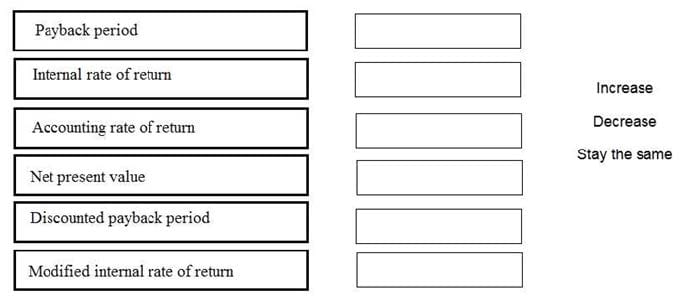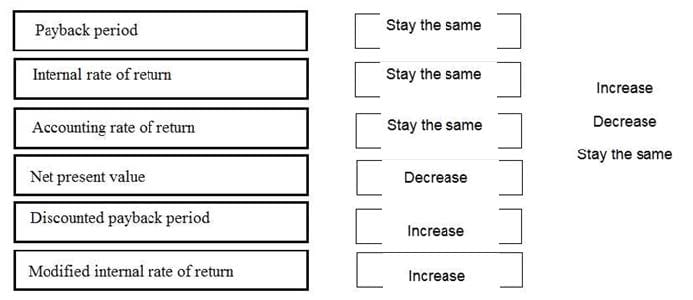CIMAPRO19-P02-1 Online Practice Questions and Answers
DRAG DROP
An investment appraisal has identified that a project has a positive net present value when discounted at the company's cost of capital. If the cost of capital is now increased, indicate whether each of the following appraisal measures will increase, decrease or stay the same.
Select and Place:

Which of the following investment appraisal methods provides an absolute monetary value on which to base decisions?
A. Accounting rate of return
B. Net present value
C. Internal rate of return
D. Profitability index
A company must decide today whether to proceed with a proposed project. If the project proceeds, the initial investment of $150,000 would be made in one year's time. The benefit of the project would be a perpetuity of $22,000 per year
commencing one year after the investment is made. The company's cost of capital is 14% per year.
To the nearest $100, what is the net present value of the project?
A. $6,300
B. $7,100
C. -$12,200
D. $25,600
There is a 60% probability of a project yielding a positive net present value (NPV) of $280,000 and a 30% probability of it yielding a positive NPV of $140,000. The only other possible outcome is that the project will yield a negative NPV of
$160,000.
What is the expected value of the project's NPV?
A. $194,000
B. $210,000
C. $280,000
D. $260,000
Which of the following statements about modified internal rate of return (MIRR) and internal rate of return (IRR) is correct?
A. MIRR uses a more realistic reinvestment assumption than IRR.
B. MIRR favours projects with long payback periods whereas IRR does not.
C. MIRR and IRR will always rank competing projects in the same order.
D. A project's MIRR will always be higher than its IRR.
A goal congruent transfer price will always:
A. motivate divisional managers by maximising divisional autonomy.
B. align the decision making of divisional managers with the objectives of the organization as a whole.
C. align the decision making of divisional managers with the maximization of divisional profit.
D. ensure that profits are shared equally between the supplying and receiving divisions.
A manufacturing company is in the process of introducing just in time (JIT) and total quality management (TQM) into every aspect of its value chain. Which TWO of the following are appropriate changes to make to the support activities in the organization's value chain?
A. Inbound logistics would need to ensure that materials of appropriate quality are delivered on a just in time basis.
B. Operations would need to be carried out on a right first time basis as any failure could delay production.
C. After sales service would need to ensure that appraisal costs are kept to a minimum.
D. Procurement would need to arrange to purchase goods so that they are delivered as required.
E. Firm infrastructure would need to arrange appropriate training courses for staff.
F. Technology development would need to ensure that processes are continually improving.
A company has just completed the production of the first 16 batches of a product. A learning curve has been observed throughout. The following table gives further details.

To the nearest whole percentage, what rate of learning is implied?
A. 87%
B. 8%
C. 84%
D. 93%
SDF makes cars. Demand for one of SDF's most popular models has declined because of a long- running television program. SDF's car is driven by a villainous character in the program and that has created such a negative association that
sales have declined so significantly that SDF is planning to discontinue production.
Which of the following statements is correct? Select ALL that apply.
A. Business risks can arise from unexpected events.
B. The use of a product in a television program can create upside risks.
C. SDF should have considered the possibility that sales of this car could be affected by public perception, even though the car's practical attributes are unchanged.
D. SDF's board should accept full responsibility for permitting this to happen.
E. SDF's sales department should have prevented the television production company from buying the car.
TTR Ltd plans to purchase a new plant for $1,000m on the 1st of January 20X6. The annual sales expected from the production of this plant is S400m per year. The plant has an expected life of five years. The financial accountant has computed the NPV of the project at $61.42m considering a discount rate of 10%. The marketing director wants to know the percentage drop in revenue that the sales team can afford before the project becomes unviable. Which of the following indicates the percentage required by the marketing director?
A. 4.05%
B. 5.05%
C. 4.5%
D. 10%


